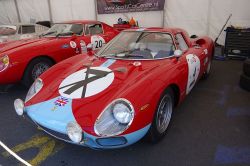Difference between revisions of "Ferrari P"
| Line 1: | Line 1: | ||
| − | [[Image:Ferrari-250-LM-'64.jpg|right|thumb|250px|1964 Ferrari 250 LM]] Although [[Enzo Ferrari]] resisted the move for road use, [[Ferrari]] began producing [[MR layout|mid-engined]] racing cars in [[1963]]. Although these cars shared their names (based on engine displacement) with road models, they were almost entirely dissimilar. The first mid-engined Ferrari road car did not arrive until the [[1967]] [[Ferrari Dino|Dino]], and it was [[1971]] before a Ferrari V12 was placed behind a road-going driver in the [[Ferrari Berlinetta Boxer|365 GT4 BB]]. ==250 P== The '''250 P''' racer was almost entirely unrelated to the other [[Ferrari 250|250 cars]]. It was a mid-engined sports car racer with a [[Ferrari 250#250 Testa Rossa|250 Testa Rossa]] [[V12]] engine. The car was produced in [[1963]] and won the [[12 Hours of Sebring]], [[24 Hours of Le Mans]], and the manufacturers' championship. ==250 LM== The 250 P evolved into a saleable mid-engined racer for the public, the '''250 LM'''. Introduced at Paris in November, [[1963]], the LM was successful for privately-entered racers around the world. About 32 models were built in [[1964]] and [[1965]], with all but the first few powered by 3.3 | + | [[Image:Ferrari-250-LM-'64.jpg|right|thumb|250px|1964 Ferrari 250 LM]] Although [[Enzo Ferrari]] resisted the move for road use, [[Ferrari]] began producing [[MR layout|mid-engined]] racing cars in [[1963]]. Although these cars shared their names (based on engine displacement) with road models, they were almost entirely dissimilar. The first mid-engined Ferrari road car did not arrive until the [[1967]] [[Ferrari Dino|Dino]], and it was [[1971]] before a Ferrari V12 was placed behind a road-going driver in the [[Ferrari Berlinetta Boxer|365 GT4 BB]]. ==250 P== The '''250 P''' racer was almost entirely unrelated to the other [[Ferrari 250|250 cars]]. It was a mid-engined sports car racer with a [[Ferrari 250#250 Testa Rossa|250 Testa Rossa]] [[V12]] engine. The car was produced in [[1963]] and won the [[12 Hours of Sebring]], [[24 Hours of Le Mans]], and the manufacturers' championship. ==250 LM== The 250 P evolved into a saleable mid-engined racer for the public, the '''250 LM'''. Introduced at Paris in November, [[1963]], the LM was successful for privately-entered racers around the world. About 32 models were built in [[1964]] and [[1965]], with all but the first few powered by 3.3 |
Revision as of 19:28, 20 December 2005
Although Enzo Ferrari resisted the move for road use, Ferrari began producing mid-engined racing cars in 1963. Although these cars shared their names (based on engine displacement) with road models, they were almost entirely dissimilar. The first mid-engined Ferrari road car did not arrive until the 1967 Dino, and it was 1971 before a Ferrari V12 was placed behind a road-going driver in the 365 GT4 BB. ==250 P== The 250 P racer was almost entirely unrelated to the other 250 cars. It was a mid-engined sports car racer with a 250 Testa Rossa V12 engine. The car was produced in 1963 and won the 12 Hours of Sebring, 24 Hours of Le Mans, and the manufacturers' championship. ==250 LM== The 250 P evolved into a saleable mid-engined racer for the public, the 250 LM. Introduced at Paris in November, 1963, the LM was successful for privately-entered racers around the world. About 32 models were built in 1964 and 1965, with all but the first few powered by 3.3
